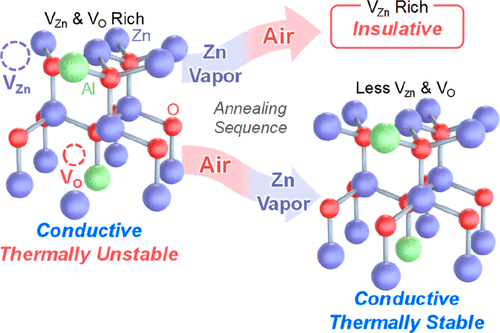当前位置:
X-MOL 学术
›
ACS Appl. Electron. Mater.
›
论文详情
Our official English website, www.x-mol.net, welcomes your feedback! (Note: you will need to create a separate account there.)
Unusual Sequential Annealing Effect in Achieving High Thermal Stability of Conductive Al-Doped ZnO Nanofilms
ACS Applied Electronic Materials ( IF 4.7 ) Pub Date : 2020-06-11 , DOI: 10.1021/acsaelm.0c00321 Ruolin Yan 1 , Tsunaki Takahashi 2, 3 , Masaki Kanai 1 , Takuro Hosomi 2, 3 , Guozhu Zhang 1 , Kazuki Nagashima 1, 3 , Takeshi Yanagida 1, 2
ACS Applied Electronic Materials ( IF 4.7 ) Pub Date : 2020-06-11 , DOI: 10.1021/acsaelm.0c00321 Ruolin Yan 1 , Tsunaki Takahashi 2, 3 , Masaki Kanai 1 , Takuro Hosomi 2, 3 , Guozhu Zhang 1 , Kazuki Nagashima 1, 3 , Takeshi Yanagida 1, 2
Affiliation

|
Emerging interactive sensor electronics requires metal oxide electrodes that possess long-term atmospheric stability and electrical conductivity to function under harsh conditions (e.g., high temperatures) in air. In this study, we report a rational method to accomplish the long-term thermal stability of conductive Al-doped ZnO (AZO) nanofilms, which have been thermally unstable due to inevitable crystal defects. Our method utilizes a sequential thermal annealing in air and Zn vapor atmosphere. An initial annealing was performed in air, followed by a second annealing in a Zn vapor atmosphere. Air tolerance tests on the resulting AZO nanofilms revealed the stable electrical resistivity (∼10–4 Ω·cm) in air, even at temperatures up to 500 °C. Conversely, when annealing was performed in the reverse sequence, the electrical resistivity of the AZO nanofilms significantly increased by 5 orders of magnitude during tolerance tests. Photoluminescence data further supported the results of the air tolerance tests. The unusual effect of the annealing–atmosphere sequence is discussed in terms of the presence of dual anion/cation vacancies and the sequential benefits when these vacancies are compensated during annealing. The applicability of these thermally stable AZO electrodes for use in nanochannel sensor devices is demonstrated. Furthermore, we show that the proposed sequential annealing method is applicable for Ga-doped ZnO films, supporting its use as a platform fabrication method. Thus, the proposed fundamental concept for tailoring thermally stable conductive metal oxide electrodes provides a foundation for designing interactive electronic devices that are stable for a long period.
中文翻译:

实现导电掺杂铝的ZnO纳米膜高热稳定性的不连续退火
新兴的交互式传感器电子设备需要具有长期大气稳定性和导电性的金属氧化物电极,以在恶劣的空气条件下(例如高温)发挥作用。在这项研究中,我们报告了一种合理的方法来实现导电Al掺杂ZnO(AZO)纳米膜的长期热稳定性,该膜由于不可避免的晶体缺陷而一直处于热不稳定状态。我们的方法利用了在空气和锌蒸气气氛中的顺序热退火。在空气中进行初始退火,然后在Zn蒸气气氛中进行第二次退火。对所得的AZO纳米膜进行的空气耐受性测试显示出稳定的电阻率(约10 –4Ω·cm),即使在最高500°C的温度下也是如此。相反,当以相反的顺序进行退火时,在耐受性测试期间,AZO纳米膜的电阻率显着增加了5个数量级。光致发光数据进一步支持了空气耐受性测试的结果。从双重阴离子/阳离子空位的存在以及退火期间补偿这些空位的顺序收益的角度讨论了退火-大气顺序的不同寻常的影响。证明了这些热稳定的AZO电极用于纳米通道传感器设备的适用性。此外,我们表明,所提出的顺序退火方法适用于掺杂Ga的ZnO薄膜,支持其用作平台制造方法。从而,
更新日期:2020-07-28
中文翻译:

实现导电掺杂铝的ZnO纳米膜高热稳定性的不连续退火
新兴的交互式传感器电子设备需要具有长期大气稳定性和导电性的金属氧化物电极,以在恶劣的空气条件下(例如高温)发挥作用。在这项研究中,我们报告了一种合理的方法来实现导电Al掺杂ZnO(AZO)纳米膜的长期热稳定性,该膜由于不可避免的晶体缺陷而一直处于热不稳定状态。我们的方法利用了在空气和锌蒸气气氛中的顺序热退火。在空气中进行初始退火,然后在Zn蒸气气氛中进行第二次退火。对所得的AZO纳米膜进行的空气耐受性测试显示出稳定的电阻率(约10 –4Ω·cm),即使在最高500°C的温度下也是如此。相反,当以相反的顺序进行退火时,在耐受性测试期间,AZO纳米膜的电阻率显着增加了5个数量级。光致发光数据进一步支持了空气耐受性测试的结果。从双重阴离子/阳离子空位的存在以及退火期间补偿这些空位的顺序收益的角度讨论了退火-大气顺序的不同寻常的影响。证明了这些热稳定的AZO电极用于纳米通道传感器设备的适用性。此外,我们表明,所提出的顺序退火方法适用于掺杂Ga的ZnO薄膜,支持其用作平台制造方法。从而,



























 京公网安备 11010802027423号
京公网安备 11010802027423号